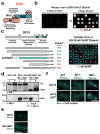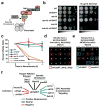Tension sensing by Aurora B kinase is independent of survivin-based centromere localization
- PMID: 23604256
- PMCID: PMC3644022
- DOI: 10.1038/nature12057
Tension sensing by Aurora B kinase is independent of survivin-based centromere localization
Abstract
Accurate segregation of the replicated genome requires chromosome biorientation on the spindle. Biorientation is ensured by Aurora B kinase (Ipl1), a member of the four-subunit chromosomal passenger complex (CPC). Localization of the CPC to the inner centromere is central to the current model for how tension ensures chromosome biorientation: kinetochore-spindle attachments that are not under tension remain close to the inner centromere and are destabilized by Aurora B phosphorylation, whereas kinetochores under tension are pulled away from the influence of Aurora B, stabilizing their microtubule attachments. Here we show that an engineered truncation of the Sli15 (known as INCENP in humans) subunit of budding yeast CPC that eliminates association with the inner centromere nevertheless supports proper chromosome segregation during both mitosis and meiosis. Truncated Sli15 suppresses the deletion phenotypes of the inner-centromere-targeting proteins survivin (Bir1), borealin (Nbl1), Bub1 and Sgo1 (ref. 6). Unlike wild-type Sli15, truncated Sli15 localizes to pre-anaphase spindle microtubules. Premature targeting of full-length Sli15 to microtubules by preventing Cdk1 (also known as Cdc28) phosphorylation also suppresses the inviability of Bir1 deletion. These results suggest that activation of Aurora B kinase by clustering either on chromatin or on microtubules is sufficient for chromosome biorientation.
Figures




Similar articles
-
Ipl1/Aurora-dependent phosphorylation of Sli15/INCENP regulates CPC-spindle interaction to ensure proper microtubule dynamics.J Cell Biol. 2011 Jul 11;194(1):137-53. doi: 10.1083/jcb.201009137. Epub 2011 Jul 4. J Cell Biol. 2011. PMID: 21727193 Free PMC article.
-
A Bir1-Sli15 complex connects centromeres to microtubules and is required to sense kinetochore tension.Cell. 2006 Dec 15;127(6):1179-91. doi: 10.1016/j.cell.2006.09.049. Cell. 2006. PMID: 17174893 Free PMC article.
-
Bub1, Sgo1, and Mps1 mediate a distinct pathway for chromosome biorientation in budding yeast.Mol Biol Cell. 2011 May;22(9):1473-85. doi: 10.1091/mbc.E10-08-0673. Epub 2011 Mar 9. Mol Biol Cell. 2011. PMID: 21389114 Free PMC article.
-
Regulation of kinetochore-microtubule attachments by Aurora B kinase.Biochem Soc Trans. 2009 Oct;37(Pt 5):976-80. doi: 10.1042/BST0370976. Biochem Soc Trans. 2009. PMID: 19754435 Review.
-
Protein kinases in mitotic phosphorylation of budding yeast CENP-A.Curr Genet. 2019 Dec;65(6):1325-1332. doi: 10.1007/s00294-019-00997-5. Epub 2019 May 22. Curr Genet. 2019. PMID: 31119371 Review.
Cited by
-
Tension promotes kinetochore-microtubule release by Aurora B kinase.J Cell Biol. 2021 Jun 7;220(6):e202007030. doi: 10.1083/jcb.202007030. J Cell Biol. 2021. PMID: 33904910 Free PMC article.
-
Suppression of chromosome instability by targeting a DNA helicase in budding yeast.Mol Biol Cell. 2023 Jan 1;34(1):ar3. doi: 10.1091/mbc.E22-09-0395. Epub 2022 Nov 9. Mol Biol Cell. 2023. PMID: 36350688 Free PMC article.
-
Meiosis I: when chromosomes undergo extreme makeover.Curr Opin Cell Biol. 2013 Dec;25(6):687-96. doi: 10.1016/j.ceb.2013.07.009. Epub 2013 Aug 2. Curr Opin Cell Biol. 2013. PMID: 23916768 Free PMC article. Review.
-
Swap and stop - Kinetochores play error correction with microtubules: Mechanisms of kinetochore-microtubule error correction: Mechanisms of kinetochore-microtubule error correction.Bioessays. 2022 May;44(5):e2100246. doi: 10.1002/bies.202100246. Epub 2022 Mar 8. Bioessays. 2022. PMID: 35261042 Free PMC article.
-
Microtubules accelerate the kinase activity of Aurora-B by a reduction in dimensionality.PLoS One. 2014 Feb 3;9(2):e86786. doi: 10.1371/journal.pone.0086786. eCollection 2014. PLoS One. 2014. PMID: 24498282 Free PMC article.
References
-
- Ruchaud S, Carmena M, Earnshaw WC. Chromosomal passengers: conducting cell division. Nat Rev Mol Cell Biol. 2007;8:798–812. - PubMed
-
- Pinsky BA, Biggins S. The spindle checkpoint: tension versus attachment. Trends Cell Biol. 2005;15:486–493. - PubMed
-
- Tanaka TU, et al. Evidence that the Ipl1-Sli15 (Aurora kinase-INCENP) complex promotes chromosome bi-orientation by altering kinetochore-spindle pole connections. Cell. 2002;108:317–329. - PubMed
Publication types
MeSH terms
Substances
Grants and funding
LinkOut - more resources
Full Text Sources
Other Literature Sources
Molecular Biology Databases
Research Materials
Miscellaneous

